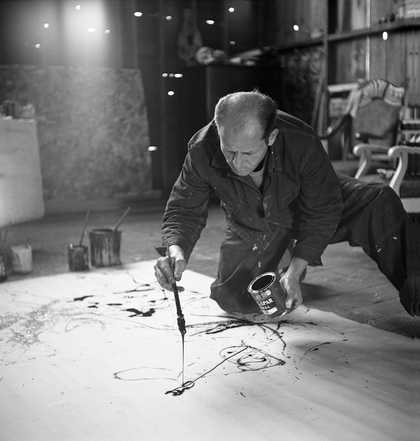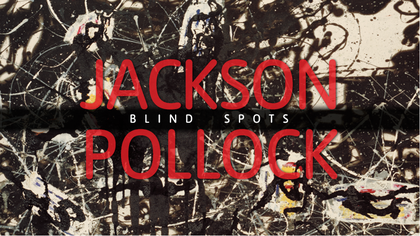
Painter Jackson Pollock working in his studio, dropping paint onto canvas
Photo By Martha Holmes/The LIFE Premium Collection/Getty Images
No matter how outlandish the truth, human nature dictates that people invariably want to embellish the known facts, to the extent that reality is at times overshadowed by the resultant fictions. A case in point is Jackson Pollock, a figure whose biography quickly became laced with legend; the mythologies conjured up over time rivalling – and often overshadowing – his artistic legacy. Of course, however, some of the best fictions have a grain of truth to them…
Pollock was limited to abstract art
Although identified as the pioneer and leading light of the abstract expressionist movement (a term coined to describe new forms of abstract art, often characterized by gestural mark-making and the impression of spontaneity), Pollock was by no means confined to this style alone. For a good deal of his career he worked figuratively, and even commented on this himself. In one of his few written statements, dated 1951, Pollock declared:
I don’t care for ‘abstract expressionism’ … and it’s certainly not ‘non-objective’, and not ‘nonrepresentational’ either. I’m very representational some of the time, and a little all of the time. But when you’re painting out of your unconscious, figures are bound to emerge… painting is a state of being… Painting is self-discovery. Every good artist paints what he is.
Pollock developed in a bubble
While it is correct to say that Pollock dismantled and redefined modernist painting, it is wrong to suggest that he arrived upon his signature style in a vacuum. Although never travelling outside of the United States, and once declaring that ‘I don’t see why the problems of modern painting can’t be solved as well here [America] as elsewhere,’ Pollock was highly conversant in European modernism; in particular with reference to the likes of Wassily Kandinsky, Joan Miro and Pablo Picasso. Indeed, Pollock filled pages of a sketchbook with his thoughts and interpretations on the latter – his admiration for Picasso’s Guernica and the studies for it are well documented.
Pollock could only paint to jazz
Pollock thought that jazz was ‘the only interesting thing to happen in this country [America]’ and after his death he left behind him a large collection of records by the likes of Louis Armstrong, Duke Ellington and Billie Holiday. In his work you can draw comparisons with the music he clearly loved: you see rhythm, variation in tempo and movement, and his drip style is regularly referred to as lyrical. It is understandable then that this led to the misconception that he could only have worked to the strains of the genre he adored. Much of his output, however, was produced in a converted barn with no power source. Unless he had a few musicians on call to play while he painted, the romantic claim that he could only do so while listening to jazz is unfounded.
Pollock was at his most prolific under the influence of alcohol
Probably the most absurd and easily refutable fantasy about Pollock was that he was at his most prolific and created his best works while drinking. Even the smallest grasp of what his technique entailed and required of him rules out that idea. Requiring of him great skill, concentration and patience, when asked about his approach to painting, Pollock asserted: ‘I can control the flow of the paint; there is no accident, just as there is no beginning and no end.’ The most productive phase of his career actually came when he had been sober for a period of two years. In contrast, his output slowed dramatically to a crawl when drinking, and during the final years of his life, as he began to lose his battle with alcohol, Pollock painted only a handful of works.
Pollock was out of ideas post abstract expressionism
It’s tempting to draw the conclusion that, once he had conquered the art world, graced magazines, been caught up in fashion shoots and declared the greatest American artist of his generation that, after the iconic period spanning 1947–1950 (and years before his death), Pollock was washed up. The exhibition Jackson Pollock: Blind Spots explores the subsequent years in which he reconfigured the language and techniques of abstract expressionism to produce a more explicitly figurative, starkly monochromatic practice. Leading critic and art historian Michael Fried would later remark that during this time, Pollock had been ‘on the verge of an entirely new and different kind of painting,’ one which was ‘of virtually limitless potential’. Another critic, Clement Greenberg no less, was quick to acknowledge that, far from out of ideas, the artist was in fact articulating ‘something different from what he had to say before’.
Pollock discovered his drip technique by chance
As has been touched upon elsewhere, the sense that the development of his famed drip technique was some kind of fortunate accident is highly reductive, one given undue weight by its depiction in the 2000 biopic Pollock, starring and directed by Ed Harris. This couldn’t be further from the truth; it was something that took him years to perfect, from experimentation in the late 1930s to his mastery of it toward the end of the following decade. His pioneering work though, proved shocking to many and he was regularly asked about his approach, fielding rather blunt questions like this one from a 1950 radio interview: ‘Mr. Pollock, there’s been a good deal of controversy and a great many comments have been made regarding your method of painting. Is there something you’d like to tell us about that?’ Remarkably, such enquiries were usually greeted with modesty, eliciting humble responses about finding new techniques for new times, or expressing feelings rather than merely illustrating them. Privately however, such scrutiny made Pollock extremely self-aware of public opinion of him, his work and his abilities.
Pollock was unwittingly part of a CIA-sponsored plot to promote US creativity
You know how, at the beginning, we said that some of the best fictions have a grain of truth to them? Well, sometimes it’s somewhat more than a grain. For a long time it had been an art world conspiracy theory that the US government, in the propaganda war with Russia, had sponsored abstract expressionism as a means of highlighting American freedom of expression versus the restricting straightjacket of Soviet conformity. Author of The Cultural Cold War: The CIA and the World of Arts and Letters, journalist and historian Frances Stonor Saunders has said that the rumours initially seemed doomed to remain just that, with no definitive proof about how – or why – the CIA might have funded the American avant-garde. Enter former CIA case officer Donald Jameson who, speaking to Stonor Saunders, confirmed that under a division titled the Propaganda Assets Inventory: ‘It was recognised that Abstract Expression- ism was the kind of art that made [the Soviet sanctioned] socialist realism look even more stylised and more rigid and confined than it was. And that relationship was exploited in some of the exhibitions.’
Who says the truth isn’t stranger than fiction?
Jackson Pollock: Blind Spots continues at Tate Liverpool until 18 October 2015

